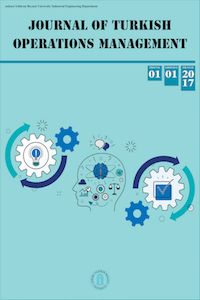Entropi tabanlı TOPSIS-Sort ile iş güvenliği risklerinin sınıflandırılması
İSG risk değerlendirme, TOPSIS-Sort, Entropi ağırlıklandırma
Classification of occupational safety risks with entropy-based TOPSIS-Sort
OHS risk assessment, TOPSIS-Sort, Entropy weighting,
___
- Adem, A. (2022). İş sağlığı ve güvenliğinde kullanılan risk analizi tekniklerinin değerlendirilmesi için bir rehber önerisi. Politeknik Dergisi, 25(3), 1319-1328. doi:https://doi.org/10.2339/politeknik.1114897
- Adem, A., Colak, A., & Dagdeviren, M. (2018). An integrated model using SWOT analysis and Hesitant fuzzy linguistic term set for evaluation occupational safety risks in life cycle of wind turbine. Safety Science, 106, 184-190. doi:https://doi.org/10.1016/j.ssci.2018.02.033
- Chen, C. Y., Wu, G. S., Chuang, K. J., & Ma, C. M. (2009). A comparative analysis of the factors affecting the implementation of occupational health and safety management systems in the printed circuit board industry in Taiwan. Journal of Loss Prevention in the Process Industries, 22(2), 210-215. doi:https://doi.org/10.1016/j.jlp.2009.01.004
- Chen, Z., Feng, K. M., Zhang, G. S., Yuan, T., & Pan, C. H. (2008). Preliminary safety research for CH HCSB TBM based on FMEA method. Fusion Engineering and Design, 83(5), 743-746. doi:https://doi.org/10.1016/j.fusengdes.2008.05.046
- de Lima Silva, D. F., & de Almeida Filho, A. T. (2020). Sorting with TOPSIS through boundary and characteristic profiles. Computers & Industrial Engineering, 141, 106328. doi:https://doi.org/10.1016/j.cie.2020.106328
- Deng, H., Yeh, C.-H., & Willis, R. J. (2000). Inter-company comparison using modified TOPSIS with objective weights. Computers & Operations Research, 27(10), 963-973. doi:https://doi.org/10.1016/S0305-0548(99)00069-6
- Djapan, M. J., Tadic, D. P., MacUzic, I. D., & Dragojovic, P. D. (2015). A new fuzzy model for determining risk level on the workplaces in manufacturing small and medium enterprises. Proceedings of the Institution of Mechanical Engineers, Part O: Journal of Risk and Reliability, 229(5), 456-468. doi:https://doi.org/10.1177/1748006X15581219
- Ersoy, M., Çelik, M. Y., Yeşilkaya, L., & Çolak, O. (2019). Combination of Fine-Kinney and GRA methods to solve occupational health and safety problems. Journal of the Faculty of Engineering and Architecture of Gazi University, 34(2), 751-770. doi:https://doi.org/10.17341/gazimmfd.416534
- Feili, H. R., Akar, N., Lotfizadeh, H., Bairampour, M., & Nasiri, S. (2013). Risk analysis of geothermal power plants using Failure Modes and Effects Analysis (FMEA) technique. Energy Conversion and Management, 72, 69-76. doi:https://doi.org/10.1016/j.enconman.2012.10.027
- Gölcük, İ., & Durmaz, E. D. (2023). An integrated decision-making model with entropy weighting and TOPSIS-Sort for occupational risk assessment. 6. International Conference on Engineering Sciences Abstract Book, 56, Ankara, Türkiye.
- Gölcük, İ., Durmaz, E. D., & Şahin, R. (2023). Prioritizing occupational safety risks with fuzzy FUCOM and fuzzy graph theory-matrix approach. Journal of the Faculty of Engineering and Architecture of Gazi University, 38(1), 57-70. doi:https://doi.org/10.17341/gazimmfd.970514
- Grassi, A., Gamberini, R., Mora, C., & Rimini, B. (2009). A fuzzy multi-attribute model for risk evaluation in workplaces. Safety Science, 47(5), 707-716. doi:https://doi.org/10.1016/j.ssci.2008.10.002
- Gul, M. (2018). A review of occupational health and safety risk assessment approaches based on multi-criteria decision-making methods and their fuzzy versions. Human and Ecological Risk Assessment, 24(7), 1723-1760. doi:https://doi.org/10.1080/10807039.2018.1424531
- Gül, M. (2021). A quantitative occupational risk assessment methodology based on TOPSIS-Sort with its application in aluminum extrusion industry. International Journal of Pure and Applied Sciences, 7(1), 163-172.
- Gul, M., Ak, M. F., & Guneri, A. F. (2017). Occupational health and safety risk assessment in hospitals: A case study using two-stage fuzzy multi-criteria approach. Human and Ecological Risk Assessment, 23(2), 187-202. doi:https://doi.org/10.1080/10807039.2016.1234363
- Hwang, C.-L., & Yoon, K. (1981). Methods for multiple attribute decision making. Multiple attribute decision making: methods and applications a state-of-the-art survey, 58-191.
- John, A., Paraskevadakis, D., Bury, A., Yang, Z., Riahi, R., & Wang, J. (2014). An integrated fuzzy risk assessment for seaport operations. Safety Science, 68, 180-194. doi:https://doi.org/10.1016/j.ssci.2014.04.001
- Korkusuz, A. Y., & Inan, U. H. (2020). Occupational health and safety performance measurement in healthcare sector using integrated multi criteria decision making methods. Journal of the Faculty of Engineering and Architecture of Gazi University, 35(1), 81-96. doi:https://doi.org/10.17341/gazimmfd.441032
- Liu, H. T., & Tsai, Y. L. (2012). A fuzzy risk assessment approach for occupational hazards in the construction industry. Safety Science, 50(4), 1067-1078. doi:https://doi.org/10.1016/j.ssci.2011.11.021
- Mahdevari, S., Shahriar, K., & Esfahanipour, A. (2014). Human health and safety risks management in underground coal mines using fuzzy TOPSIS. Science of the Total Environment, 488-489(1), 85-99. doi:https://doi.org/10.1016/j.scitotenv.2014.04.076
- Makin, A.-M., & Winder, C. (2008). A new conceptual framework to improve the application of occupational health and safety management systems. Safety Science, 46(6), 935-948. doi:https://doi.org/10.1016/j.ssci.2007.11.011
- Mizrak Özfirat, P. (2014). A new risk analysis methodology integrating fuzzy prioritization method and failure modes and effects analysis. Journal of the Faculty of Engineering and Architecture of Gazi University, 29(4), 755-768. doi:https://doi.org/10.17341/gummfd.04423
- Sabokbar, F. H., Hosseini, A., Banaitis, A., & Banaitiene, N. (2016). A novel sorting method TOPSIS-SORT: an applicaiton for Tehran environmental quality evaluation. E & M Ekonomie a Management, 19 (2) (2016), 87-104, doi:https://doi.org/10.15240/tul/001/2016-2-006
- Shannon, C. E. (1948). A mathematical theory of communication. The Bell system technical journal, 27(3), 379-423. doi:https://doi.org/10.1002/j.1538-7305.1948.tb01338.x
- Sousa, V., Almeida, N. M., & Dias, L. A. (2015). Risk-based management of occupational safety and health in the construction industry - Part 2: Quantitative model. Safety Science, 74, 184-194. doi:https://doi.org/10.1016/j.ssci.2015.01.003
- Wang, T.-C., & Lee, H.-D. (2009). Developing a fuzzy TOPSIS approach based on subjective weights and objective weights. Expert Systems with Applications, 36(5), 8980-8985. doi:https://doi.org/10.1016/j.eswa.2008.11.035
- Yilmaz, N., & Senol, M. B. (2017). A model and application of occupational health and safety risk assessment. Journal of the Faculty of Engineering and Architecture of Gazi University, 32(1), 77-87. doi:https://doi.org/10.17341/gazimmfd.300597
- ISSN: 2630-6433
- Başlangıç: 2017
- Yayıncı: Ankara Yıldırım Beyazıt Üniversitesi
Bir Mobilya Üretim Tesisi İçin Üretim Geliştirme Mühendisi Seçimi
Rabia YUMUŞAK, Bedirhan SARIMEHMET, Tamer EREN
Aslı BEKTAŞ KAMIŞLIK, Büşra ALAKOÇ, Tulay KESEMEN, Tahir KHANIYEV
New Generation FMEA Method in Automotive Industry: An Application
Nesimi KÖK, Mehmet Selami YILDIZ
Maryam EBRAHİMİ, Kamran YEGANEGİ
A Literature Review on Potential Decision Problems for Vehicle Sharing Systems
İpek Damla AKPINAR, Barış KEÇECİ
Entropi tabanlı TOPSIS-Sort ile iş güvenliği risklerinin sınıflandırılması
Esra Duygu DURMAZ, İlker GÖLCÜK
A Monte Carlo simulation approach to the gap-time relationship in solving scheduling problem
